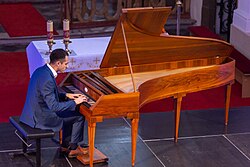Fortepiano
A fortepiano is an early piano. It normally means pianos from the 18th century to the early 19th century.[1] The first fortepiano was invented by Bartolomeo Cristofori in Florence. The idea soon spread in Europe.[2]
Fortepiano Media
Overture from Le calife de Bagdad (1809) by François-Adrien Boieldieu, played on a fortepiano
A 1720 fortepiano by Cristofori in the Metropolitan Museum of Art in New York City. It is the oldest surviving piano.
Fortepiano by Conrad Graf in the Reiss-Engelhorn-Museen, Mannheim
Zumpe's, or Masons, action drawn from the instrument of 1766. 1) key, 2) jack, a wire with leather stud on top, known by the workmen as the "old man's head", 3) whalebone rear guide, projects from the end of the key, works in a groove to keep the key steady, 4) hammer, 5) whalebone jack, called the 'mopstick', 6) damper, 7) whalebone damper spring
References
- ↑ Ripin, Edwin M. (2001). Fortepiano (i). Oxford University Press. doi:10.1093/gmo/9781561592630.article.10016.
- ↑ Badura-Skoda, Eva (2017). The Eighteenth-Century Fortepiano Grand and Its Patrons: From Scarlatti to Beethoven. Indiana University Press. doi:10.2307/j.ctt2005v7j. ISBN 978-0-253-02263-9. JSTOR j.ctt2005v7j.






